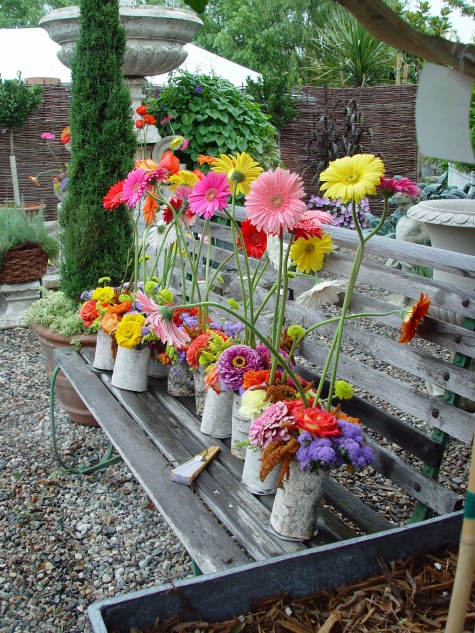No doubt I spend much too much time mourning the passing of the summer season. I am too slow to fish out my boots and jacket; I obssess about the last rose of summer to Buck ad nauseum. The cold irritates me to no end. In much the same vein, a client remarked the other day that nothing was going on in her garden anymore-it was over. We spent some time commiserating about all the things that were wrong with the weather. Too cold, too rainy, too windy, too dark-neither of us were liking one thing about it. Towards the end of this exchange, the humor of it finally came to our rescue-we got to laughing. In spite of our whining and sulking, nothing has come to an end-it is changing.
Though the last time I had a big zest for change was probably 45 years ago, I thrive on big fluid situations. The most succinct definition of the state of being in business I have ever read came from Vera Wang; “being in business is like keeping 300 marbles on a table all at once”. I might add that while in the process of keeping all those marbles from dropping off, one needs to regularly add new marbles to the existing mix. Getting over one’s grief about the marble that has in fact dropped off is equally as important; taking your eye off the rest of the balls for too long comes to no good end. I don’t see that the process of living a life, working a job, or growing a garden asks for any different. I have been watching the starch go out of the massive leaves of my Sum and Substance hostas for 10 days now. The chartreuse leaves loose chlorophyll and turn yellow; the softened stems finally give in to gravity, and bend. Those stiff puckered leaves droop to the ground as if they were melting. They are melting. In short order, should I not remove them, they will completely collapse in a gooey heap and decompose. I must be moving on into the new season; this morning the drama of all that drooping made me laugh.
The prime mover in all of these changes is of course the weather. The day length is shortening. The day and night temperatures drop. Wind, rain and fog deliver the message that the season is in transition. There comes a day in every gardener’s life when the the light finally comes on-that day when you understand to the bone that the garden is outside. As in, outside of your control. It may take a powerful storm, or a sudden frost, or a thaw in January that forces water back up under your shingles and into the kitchen for that thought to take hold. In my case, a visit to the vast conservatory at Longwood Gardens marked the day when I really understood that most of what goes on in the landscape is not at my direction. The giant vaulted glass roof of the vast exhibition hall excludes all the weather except for the light or lack thereof of the sun. In the working sections of the conservatory, plants being grown for seasonal display are grown under lights; natural light would interfere too much with the production schedule. The fall chrysanthemums and holiday pointsettias have a staging date already set. There is an enormous amount of time and effort expended to control every aspect of plant culture; in return, this space is as close to perfectly green as can be, all year round. I was struck as if by lightening; this is not a garden. It is a grand effort which has produced a reasonable facsimile of a garden.
This is exactly why I feel that good landscape design deliberately celebrates the daily action that we call weather. There is no such thing as a day off from weather; by my calculation, I have lived with daily weather some 21,535 days. This in and of itself is not so remarkable. That every day the weather is in some way changing, and certainly different than the day before – extraordinary. As a result, every place in my garden there is something new to look at. At this moment, the asparagus going gold yellow, the fallen leaves randomly dotting my lawn, the alyssum volunteers blooming in the gravel walk, the fresh foliage thrown by the grape hyacinths, the hellebores setting buds and the dogwoods fruiting-there is plenty going on. I have my branches back; the structure of which is different from tree to tree, and shrub to shrub. The bare branches are every bit as interesting and beautiful as branches in leaf. The slanting October light on the branches-gorgeous. A days rain waters my freshly planted tulip bulbs in; I so look forward to the ritual of the putting away of the hoses. A storm coat, a pair of muck boots, and my mud gloves are all that it takes to get me out there. I am able to put away the spade and the trowel in favor of the experiential tools I have on me all the time. I can smell the coming of the cold. I can see the geese migrating. I can hear the rain on the roof and the wind blowing just fine from inside; I can walk outside should I wish to turn up the volume. I can keep my hands in my pockets. But no matter what I should decide to do or not do in my garden, there is always plenty going on.


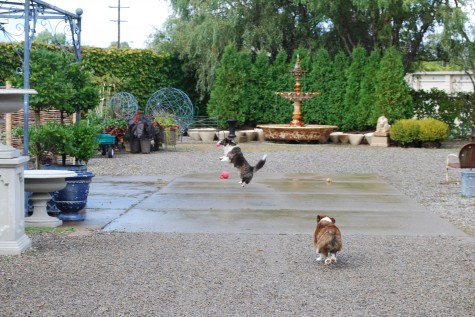

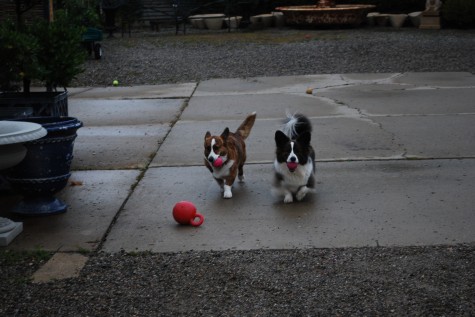





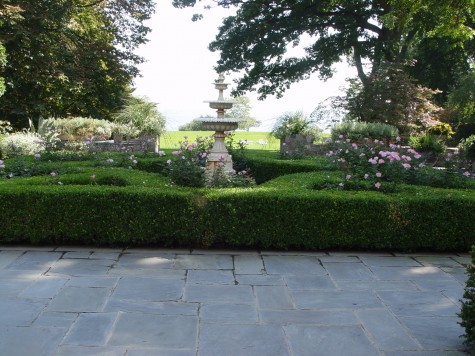 I have clients whose interest in gardens runs to green, and more green. Though my love for the green of the plant is every bit as great as my love for their flowers, I have never had the discipline it takes to restrict my own palette like this. But I find that whenever a client represents their own point of view outdoors, the result looks just right.
I have clients whose interest in gardens runs to green, and more green. Though my love for the green of the plant is every bit as great as my love for their flowers, I have never had the discipline it takes to restrict my own palette like this. But I find that whenever a client represents their own point of view outdoors, the result looks just right.  These large stone and brick piers punctuate a pair of walls that partially enclose a terrace. I plant them with a mix of plants whose textures are as unlike stone and brick as possible. This is a matter of directing visual attention. The window boxes on the roof of my shop are not so gorgeous. They are made of galvanized sheet metal ordinarily used in the production of ductwork for the heating and cooling industry. The sole function of those boxes is to hold the soil, nutrients and water for the plants-they have no visual interest in and of themselves. The intent here is to acknowledge the beautiful surface of the container as much as the planting.
These large stone and brick piers punctuate a pair of walls that partially enclose a terrace. I plant them with a mix of plants whose textures are as unlike stone and brick as possible. This is a matter of directing visual attention. The window boxes on the roof of my shop are not so gorgeous. They are made of galvanized sheet metal ordinarily used in the production of ductwork for the heating and cooling industry. The sole function of those boxes is to hold the soil, nutrients and water for the plants-they have no visual interest in and of themselves. The intent here is to acknowledge the beautiful surface of the container as much as the planting.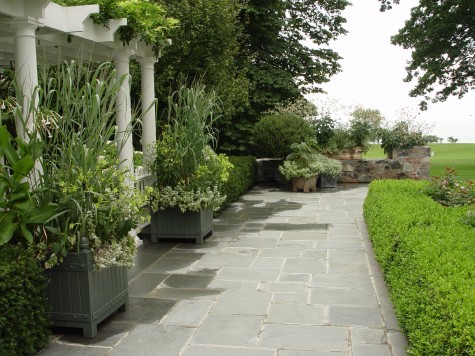 A green planting has a quiet and serene look, as the greens so closely relate in color and value. The green of these painted Belgian oak boxes harmonizes with the color of the bluestone terrace; the relationship is a subtle one. The Dallas Blues panic grass repeats that color. Monochromatic color schemes tend to read that way, although an ocean of orange is anything but serene. Add some contrasting purple to that orange, which in turn contrasts with the green, and you have a visual party going on. These greens speak softly.
A green planting has a quiet and serene look, as the greens so closely relate in color and value. The green of these painted Belgian oak boxes harmonizes with the color of the bluestone terrace; the relationship is a subtle one. The Dallas Blues panic grass repeats that color. Monochromatic color schemes tend to read that way, although an ocean of orange is anything but serene. Add some contrasting purple to that orange, which in turn contrasts with the green, and you have a visual party going on. These greens speak softly.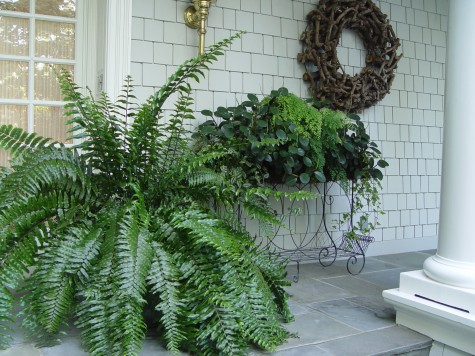 A porch planting plays the spiky texture of a tropical fern off the round chubby leaves of a of large scale pepperomia; the effect is pleasing, not demanding. The elegant English wirework planter reminiscent of vintage conservatory furniture is balanced with a simple and very rustic wreath that hangs on the wall year round.
A porch planting plays the spiky texture of a tropical fern off the round chubby leaves of a of large scale pepperomia; the effect is pleasing, not demanding. The elegant English wirework planter reminiscent of vintage conservatory furniture is balanced with a simple and very rustic wreath that hangs on the wall year round. The container collection is a beautiful one. An American stoneware grape panel container from the 1920’s, and English lead and the Belgian oak box are very different in materials and forms, but very much alike in feeling.
The container collection is a beautiful one. An American stoneware grape panel container from the 1920’s, and English lead and the Belgian oak box are very different in materials and forms, but very much alike in feeling.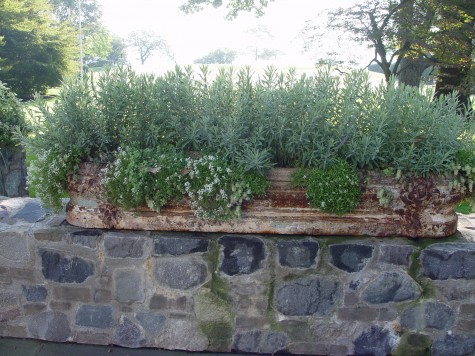 A pair of very old and distinctive French iron planters sit on the walls. I usually plant them with lavender, and alyssum, showy oregano, and whatever other herb like plant seems appropriate. The effect is graceful; the muted colors of every aspect of this space invite contemplation.
A pair of very old and distinctive French iron planters sit on the walls. I usually plant them with lavender, and alyssum, showy oregano, and whatever other herb like plant seems appropriate. The effect is graceful; the muted colors of every aspect of this space invite contemplation.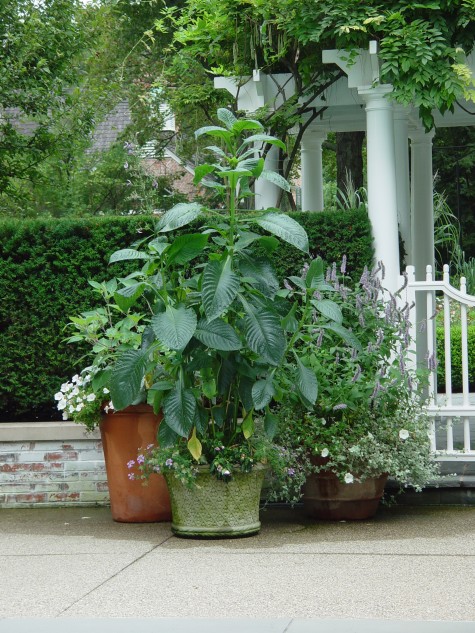 Some plants stay green all season, as our summer is too short to permit flowering-as in this large tropical salvia. The fine perennial hyssop hangs on to the ghostly lavender of its flowers a very long time; this is repeated in a lavender trailing verbena. Though there is some color here, it is the relationships of the greens that reads first and foremost.
Some plants stay green all season, as our summer is too short to permit flowering-as in this large tropical salvia. The fine perennial hyssop hangs on to the ghostly lavender of its flowers a very long time; this is repeated in a lavender trailing verbena. Though there is some color here, it is the relationships of the greens that reads first and foremost. I think the leaves of tibouchina grandiflora are surely my favorite. The large oval leaves are completely covered in fine white hairs; they are a marvel. Their contrast to the needles of the rosemary topiary is considerable in form, and little in color. Variegated licorice is one of the most versatile of all green plants. The leaves sport two different shades of green; the blotches are very blue green, while the edges are more yellow-green. It works with every plant with which it is paired. This collection of pots benefits from the lively effect of its habit of growth, and relative lightness. Subtle does not mean sleepy.
I think the leaves of tibouchina grandiflora are surely my favorite. The large oval leaves are completely covered in fine white hairs; they are a marvel. Their contrast to the needles of the rosemary topiary is considerable in form, and little in color. Variegated licorice is one of the most versatile of all green plants. The leaves sport two different shades of green; the blotches are very blue green, while the edges are more yellow-green. It works with every plant with which it is paired. This collection of pots benefits from the lively effect of its habit of growth, and relative lightness. Subtle does not mean sleepy.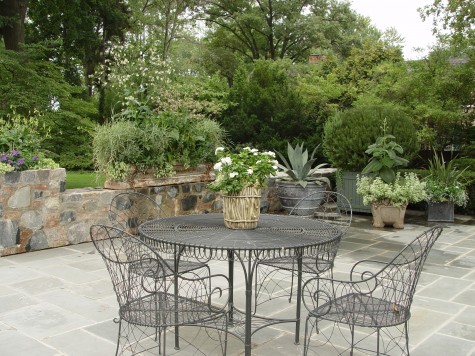
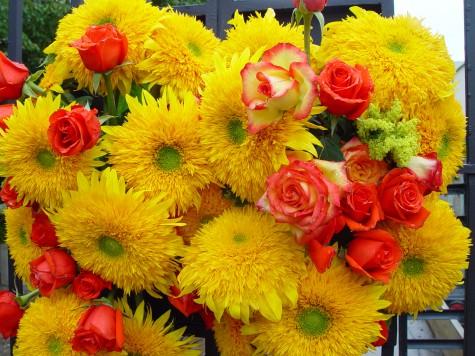 As my clients were bound and determined that Allie, Snoopy and Vladdy would be members of their wedding party, their choices for a wedding venue were slim to none. I was happy for them to get married at the shop, and equally happy to welcome the canine members of their family. Since the decision was made some six months prior to the ceremony, I had the chance to plan a garden that would look great on their late, late summer date.
As my clients were bound and determined that Allie, Snoopy and Vladdy would be members of their wedding party, their choices for a wedding venue were slim to none. I was happy for them to get married at the shop, and equally happy to welcome the canine members of their family. Since the decision was made some six months prior to the ceremony, I had the chance to plan a garden that would look great on their late, late summer date.  A copper pergola would provide the chuppah necessary for the ceremony. We infilled the poles at each corner with birch bark tubes. This blue and white scheme dictated the selection of plants as much as the season would. A collection of Italian cypress, giant rosemary topiaries, kales and cabbages would look swell come wedding time. Luckily a local grower has a very late batch of sunflowers, including the ultra double “teddy bear”. That intense yellow would warm up the arbor in a happy and sunny way. A goldenrod garland casually draped over the chuppah provided the roof necessary for the ceremony.
A copper pergola would provide the chuppah necessary for the ceremony. We infilled the poles at each corner with birch bark tubes. This blue and white scheme dictated the selection of plants as much as the season would. A collection of Italian cypress, giant rosemary topiaries, kales and cabbages would look swell come wedding time. Luckily a local grower has a very late batch of sunflowers, including the ultra double “teddy bear”. That intense yellow would warm up the arbor in a happy and sunny way. A goldenrod garland casually draped over the chuppah provided the roof necessary for the ceremony.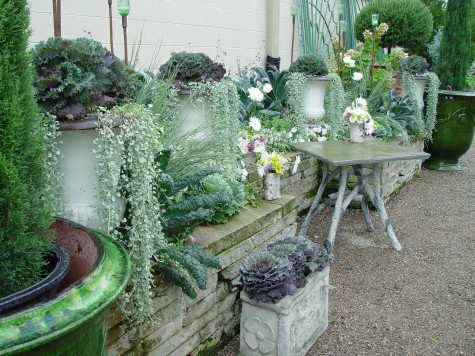 Silver dichondra has a distinctly blue cast; its diminuitive felted leaves were a great contrast to the giant blistered kale, “Nero di Toscano”. Short blue foliaged fescues, white million bells and showy oregano made good companions for the massive cabbages. White iron urns showed off the long tails of dichondra to good advantage.
Silver dichondra has a distinctly blue cast; its diminuitive felted leaves were a great contrast to the giant blistered kale, “Nero di Toscano”. Short blue foliaged fescues, white million bells and showy oregano made good companions for the massive cabbages. White iron urns showed off the long tails of dichondra to good advantage. As the ceremony required a table be available for the Rabbi, my clients chose a carved concrete faux bois piece whose legs were carved and acid stained to look like birch. The wedding party flowers in lime green, white, and lavender repeated the color scheme of the garden. Is that old rosemary topiary not a dream come true?
As the ceremony required a table be available for the Rabbi, my clients chose a carved concrete faux bois piece whose legs were carved and acid stained to look like birch. The wedding party flowers in lime green, white, and lavender repeated the color scheme of the garden. Is that old rosemary topiary not a dream come true?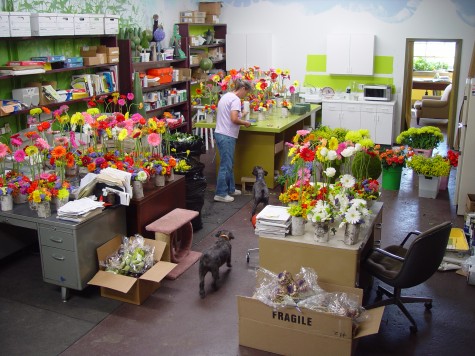 The plan for the reception involved nine 8′ long tables set end to end in the drive. Small glass vases covered in short birch bark tubes held late summer garden flowers available from the growers at my local farmer’s market. These 45 small arrangements centered on the tables would run for the entire 72 foot long reception dinner table.
The plan for the reception involved nine 8′ long tables set end to end in the drive. Small glass vases covered in short birch bark tubes held late summer garden flowers available from the growers at my local farmer’s market. These 45 small arrangements centered on the tables would run for the entire 72 foot long reception dinner table.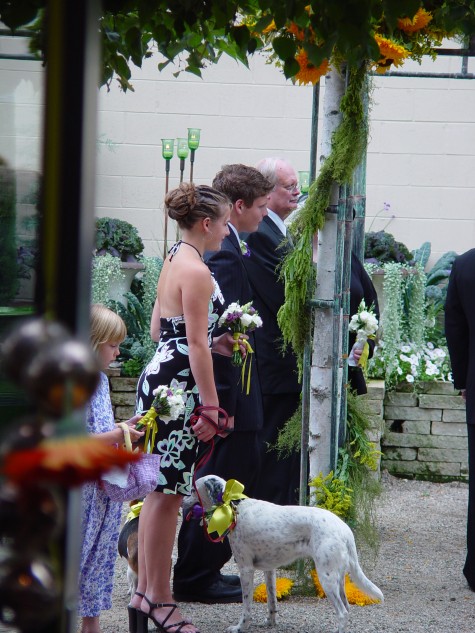 Allie and Snoopy were nervous, but they did take their big lime green satin bow and flower collars in stride. They did mill around-but just a little bit. All in all they were very well behaved.
Allie and Snoopy were nervous, but they did take their big lime green satin bow and flower collars in stride. They did mill around-but just a little bit. All in all they were very well behaved.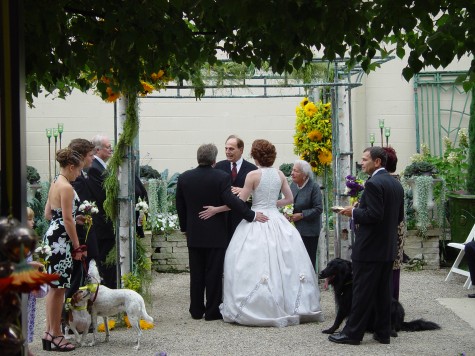 Vladdy was ordinarily fairly dignified and unflappable; he sat calmly through the entire ceremony.
Vladdy was ordinarily fairly dignified and unflappable; he sat calmly through the entire ceremony. 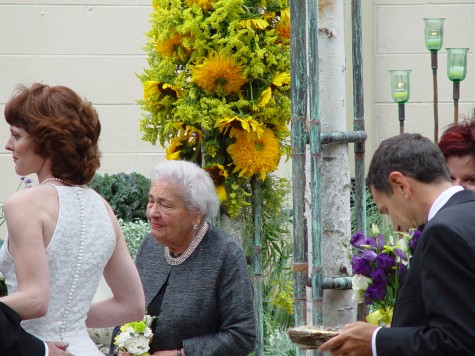 It was a beautiful wedding, and I was happy to have a part in it. There is something so satisfying about a small ceremony for everyone involved. When there are but a few details, every detail can be very personal and thoughtful. I think they were so pleased to be able to have their dog family there that day.
It was a beautiful wedding, and I was happy to have a part in it. There is something so satisfying about a small ceremony for everyone involved. When there are but a few details, every detail can be very personal and thoughtful. I think they were so pleased to be able to have their dog family there that day.